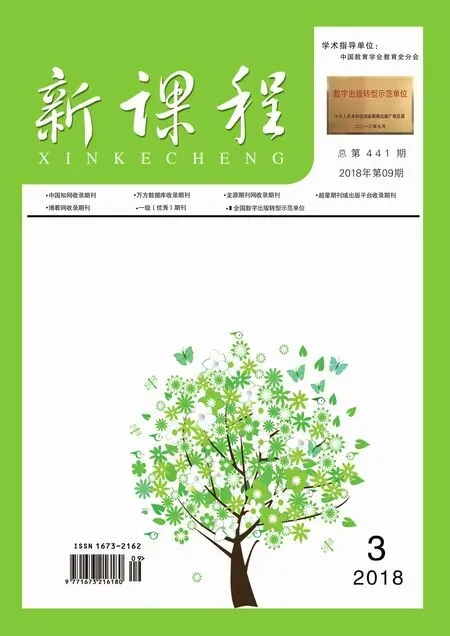高中英語閱讀教學中高階思維品質培養的策略研究
史 斯
(浙江省寧波市鄞江中學)
語言是思維的工具,也是人們交流思想的工具。思維是語言的核心要素。英語要為思而教,這個觀點已經普遍受到英語專家和教師們的認同。閱讀是高中英語教學的重要內容,教師應對英語閱讀教學文本進行深入解讀,使讀者與語篇之間進行互動,對其闡述的觀點或隱含的信息進行深層次理解和評鑒,從而促進學生評判性思維能力的發展。筆者結合具體教學案例,總結了以下幾點日常閱讀教學設計思路上較為實用有效的策略。
一、細微處見真章(以文本中不起眼詞匯為切入點)
【課例片段1】:人教版高中英語必修教材第三模塊第二單元Healthy eating的閱讀文本講述了王鵬和永慧的餐廳競爭故事。文章第一段中作者向讀者展現了王鵬那空蕩蕩的無人光顧的餐廳。許多老顧客匆匆經過,卻不進去吃飯,包括好朋友老李。當王鵬向老李打招呼的時候,Li Chang seemed not to hear。筆者在解讀文本過程中,對seem這個詞產生了濃厚的興趣。在教學過程中,教師向學生提出如下疑問:
T:Why does the writer use“seem”?What can we infer from this word?
Ss:“Seem” means something not real.So Lao Li must have been pretending not to hear Wang Peng’s words,which implied Lao Li wasn’t willing to enter Wang’s restaurant as usual.Maybe he didn’t like Wang’s food.
【說明】學生的閱讀興趣因為看似簡單的seem一詞而被調動,立足整體篇章立意,思維順暢生長,對文本內容進行預測和自我評判,所學的語言積累也得到輸出,對于接下去的文本內容的學習和探索欲被充分激發。
【課例片段2】:人教版高中英語必修教材第三模塊第五單元的單元話題是Canada——“The True North”,而單元閱讀文本的題目是A trip on“The True North”。兩處都用到了“The True North”,如不細心研讀,會容易認為所指都為加拿大這個國家。但筆者研讀后產生以下思考,如果都指加拿大這個國家,標題中為什么不表達成A Trip in或者around“The True North”呢?on這個介詞的使用是有什么特殊含義嗎?因此標題中on這個介詞就是一個很好的思維激發點,啟發學生思考標題中“The True North”的真正含義。故教學中筆者提問如下:
T:What does“The True North” in the title refe to?Why did the writer use“on” rahter than other prepositons?
在教學過程中學生帶著此疑問,饒有興趣地從文本中找出相關支持信息:
Ss:He was going to take them and their baggage to catch“the True North”——the cross-canada train.“The True North”refers to the train.We usually use“on a train” instead of“in a train”.
學生恍然大悟,原來標題中的“The True North”指的是以“The True North”命名的列車。因此也能進一步理解為何介詞使用的是on而不是其他。
【說明】此案例中,一個小小的介詞引發的思考就是學生對文本進行審視和質疑的過程,通過提供足夠的證據對自己的觀點進行合理的支撐,這就是評判性思維的生長過程。
二、層層鋪墊,環環相扣(教學過程中以問題鏈形式促思維生長)
【課例片段3】:人教版高中英語必修教材第三模塊第一單元Festivals and celebrations一課中,筆者在學生第二次精讀文本時進行以下提問:
Q1:Festivals have already existed since the ancient times, and when did they celebrate?
Q2:Then why would people celebrate at these times of the year?
Q3:What about festivals today?Which sentence do you think tells the origins of today’s festivals?


【說明】問題一“古代節日慶祝的時間是什么時候”屬于展示型問題,學生很容易在相應的段落里找到答案。教師順接著此問題繼續提問“為什么要在這些時間里舉行慶祝”,此問題建立在第一個問題的基礎上,是對第一個問題的發展。答案無法在文本里找到,真正用意在于讓學生聯系已有知識積累展開思考,形成自己的理解和判斷。
【課例片段4】:人教版高中英語必修教材第三模塊第一單元Festivals and celebrations一課中,介紹到不同文化民族對亡靈節日(Festivals of the Dead)的對待方式。該教學過程中不僅讓學生了解中西方民族對待亡靈節的相似性和區別,更要啟發學生思考其背后的文化差異。教學過程設計如下:
Step2:Detailed Reading(Para2 Festivals of the Dead)
T:Ok.Let’s move to the “Festivals of the Dead”,including Obon,Day of the Dead and Halloween.Can you read the sentence that tells the origin?
Ss:Some festivals are held to honor the dead or to satisfy the ancestors,who might return either to help or to do harm.
T:Why did they do so? What’s people’s common belief about the origin?
Ss:They believed in the return of the spirits(亡靈)of the dead ancestors.
T:Does China have such kind of festival?
Ss:In fact,China also has a similar festival“Qingming Festival”.
T:So would you compare these four festivals and list their similarities and differences?
Ss:Similarities:(Japan&China&Mexico)clean graves and offer gifts to the dead.Differences:Mexicans eat special food that look like bones while other countries don’t.On western Halloween,Children dress up and play tricks to have fun.
T:Quite good.From what you’ve found,can you see people’s different attitudes to death?
Ss:Asian people are more serious about death while westerners view death in a more humorous way,which is also a reflection of different culture and customs.
【說明】確實,亞洲國家譬如中國、日本等多以掃墓等嚴肅的方式祭奠逝去的親友;而西方國家慶祝萬圣節的時候,人們則會化裝打扮互相捉弄,以更為詼諧幽默的態度來度過亡靈節日。對待亡靈節日的方式折射出的是世界上不同民族的文化傳統和習俗的差異性。
總之,閱讀教學中教師應該盡可能地運用各種有效策略和手段,動態啟發學生的思維,在不經意間學生的思維將得到激發與生長;同時借助文本語境,融合文化內涵,使思維順勢開闊,從而推動思維的跨文化交流。
[1]張惠娥.高中英語文學閱讀“為思而教”的導學實踐[J].中小學外語教學(中學篇),2015(3).
[2]葛炳芳.對教學材料使用的探討[J].教學月刊中學版,2009(8).
[3]朱紫菁.淺談高中英語文本的多視角解讀運用[J].中小學英語教學與研究,2015(7).

